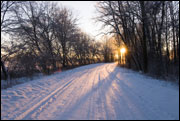Winter solstice and the shaman within
It is we ourselves who must don the shaman's mask.
The dwindling of the sun’s light in autumn is a reminder that even as the old year dies, so must all living things. The shaman helps the tribe to accept this universal dying, to understand it is necessary for new life. When the daylight hours are shortest, we long for assurance that spring will return, that once again the warm sun will nurture growing things and make the earth green. In this time when foliage has all but disappeared, we look to the trees whose evergreen boughs offer us hope.
In the era of global warming, we are conscious more than ever of our mutual dependence on trees and other living plants as we exchange our carbon dioxide for their oxygen. It is the shaman we must look to—the shaman within, the voice still and small inside of us that urges us to be a giver who will ensure our community’s well-being.
I breathe the trees
and the trees breathe me,
mouth-to-bud resuscitation,
a holy exchange of elements.
We balance the earth in its orbit
and make all things new.
From earliest times, the tree was a symbol of connectedness. With its roots deep below the ground, its trunk solidly on the earth, and its branches reaching into the heavens, it was seen as the Tree of Life, the World Tree, the cosmic axis that connects the human to the divine. It was up this World Tree, this pole that rose through the smoke hole of the tent that the shaman journeyed in an altered state of consciousness. In this ecstatic trance state, the shaman’s soul was believed to leave the body and ascend to the heavens or descend to the underworld. The shaman was a bridge between the worlds who could discern the truths of other spheres and bring back messages from beyond the wild blue yonder to the members of the tribe—messages that were important to their well-being.
Sometimes the messages were about practical things concerning the year to come, like what to plant, when to harvest, where to hunt, for shamans often served as environmental protection agents harmonizing the behavior of their people with the natural world. Sometimes the message was about how to treat an illness of someone in the tribe, for the shaman was also a healer.
And sometimes the message was a spiritual gift—a secret that enabled the people of the tribe to achieve some truly great thing or understand some profound truth.
As the new year unfolds, let us remember: It is we ourselves who must don the shaman’s mask. It is we who must journey deep into the realms of the spirit. It is we who must return to teach the celebration of the Dance of Life.
See sidebar for links to related resources.
Comments powered by Disqus







